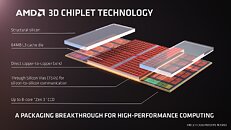T0@st
News Editor
- Joined
- Mar 7, 2023
- Messages
- 2,543 (3.50/day)
- Location
- South East, UK
| System Name | The TPU Typewriter |
|---|---|
| Processor | AMD Ryzen 5 5600 (non-X) |
| Motherboard | GIGABYTE B550M DS3H Micro ATX |
| Cooling | DeepCool AS500 |
| Memory | Kingston Fury Renegade RGB 32 GB (2 x 16 GB) DDR4-3600 CL16 |
| Video Card(s) | PowerColor Radeon RX 7800 XT 16 GB Hellhound OC |
| Storage | Samsung 980 Pro 1 TB M.2-2280 PCIe 4.0 X4 NVME SSD |
| Display(s) | Lenovo Legion Y27q-20 27" QHD IPS monitor |
| Case | GameMax Spark M-ATX (re-badged Jonsbo D30) |
| Audio Device(s) | FiiO K7 Desktop DAC/Amp + Philips Fidelio X3 headphones, or ARTTI T10 Planar IEMs |
| Power Supply | ADATA XPG CORE Reactor 650 W 80+ Gold ATX |
| Mouse | Roccat Kone Pro Air |
| Keyboard | Cooler Master MasterKeys Pro L |
| Software | Windows 10 64-bit Home Edition |
Barron's Magazine has been on a technology industry kick this week and published their interview with AMD CEO Dr. Lisa Su on May 3. The interviewer asks Su about her views on Moore's Law and it becomes apparent that she remains a believer of Gordon Moore's (more than half-century old) prediction - Moore, an Intel co-founder passed away in late March. Su explains that her company's engineers will need to innovate in order to carry on with that legacy: "I would certainly say I don't think Moore's Law is dead. I think Moore's Law has slowed down. We have to do different things to continue to get that performance and that energy efficiency. We've done chiplets - that's been one big step. We've now done 3-D packaging. We think there are a number of other innovations, as well." Expertise in other areas is also key in hitting technological goals: "Software and algorithms are also quite important. I think you need all of these pieces for us to continue this performance trajectory that we've all been on."
When asked about the challenges involved in advancing CPU designs within limitations, Su responds with: "Yes. The transistor costs and the amount of improvement you're getting from density and overall energy reduction is less from each generation. But we're still moving (forward) generation to generation. We're doing plenty of work in 3 nanometer today, and we're looking beyond that to 2 nm as well. But we'll continue to use chiplets and these type of constructions to try to get around some of the Moore's Law challenges." AMD and Intel continue to hold firm with Moore's Law, even though slightly younger upstarts disagree (see NVIDIA). Dr. Lisa Su's latest thoughts stay consistent with her colleague's past statements - AMD CTO Mark Papermaster reckoned that the theory is pertinent for another six to eight years, although it could be a costly endeavor for AMD - the company believes that it cannot double transistor density every 18 to 24 months without incurring extra expenses.



View at TechPowerUp Main Site | Source
When asked about the challenges involved in advancing CPU designs within limitations, Su responds with: "Yes. The transistor costs and the amount of improvement you're getting from density and overall energy reduction is less from each generation. But we're still moving (forward) generation to generation. We're doing plenty of work in 3 nanometer today, and we're looking beyond that to 2 nm as well. But we'll continue to use chiplets and these type of constructions to try to get around some of the Moore's Law challenges." AMD and Intel continue to hold firm with Moore's Law, even though slightly younger upstarts disagree (see NVIDIA). Dr. Lisa Su's latest thoughts stay consistent with her colleague's past statements - AMD CTO Mark Papermaster reckoned that the theory is pertinent for another six to eight years, although it could be a costly endeavor for AMD - the company believes that it cannot double transistor density every 18 to 24 months without incurring extra expenses.



View at TechPowerUp Main Site | Source






